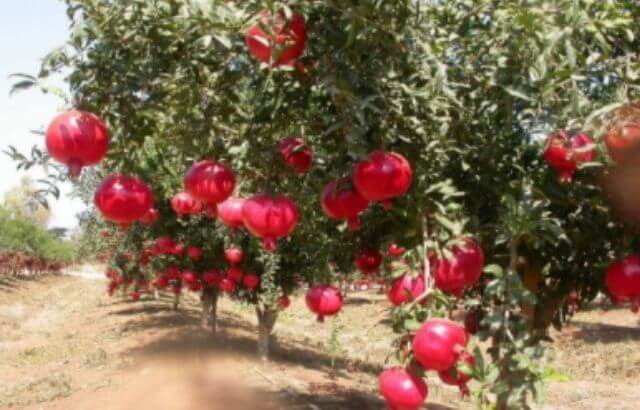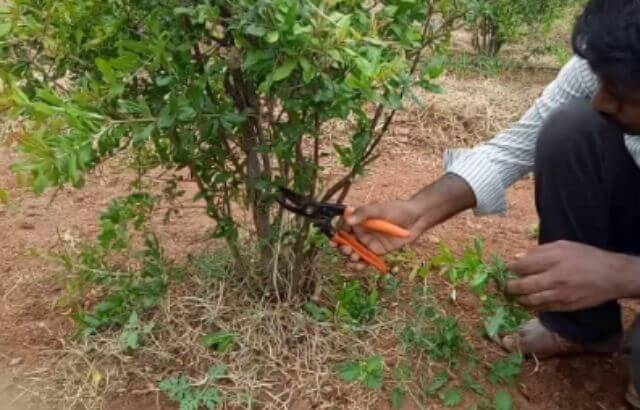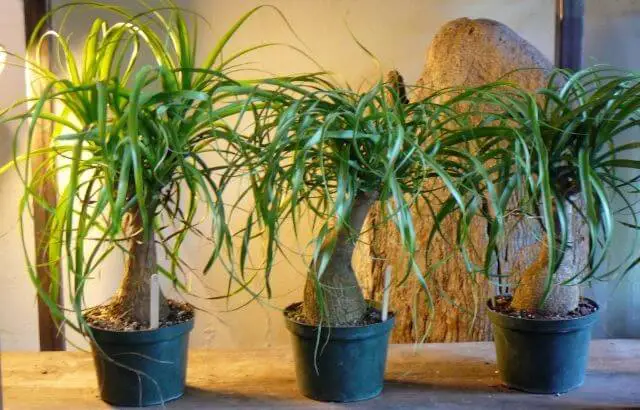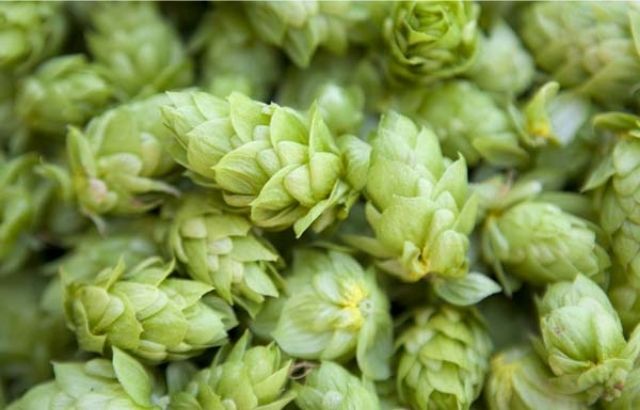Pomegranate is a flowering and fruiting plant that belongs to the genus of shrubs and small trees. This tree’s development is that they are inclined to uncontrolled development of branches and thickening. For proper development, fruiting, and a well-groomed look, pomegranate pruning is required. The method and timing of pruning will depend on how it is grown and what shape the grower wants to achieve. In this guide, I will guide you on how to prune a pomegranate tree.
How to Prune a Pomegranate Tree
Pruning a pomegranate tree is an important step in growing a garden or indoor plant. With regular, competent pruning, it becomes easier to care for the tree. But it would help if you trimmed the pomegranate correctly; otherwise, there is a risk of damaging its growth.
How to Prune Pomegranates in spring
Pomegranates’ fruit trees are most often pruned in the spring, in early April, before active vegetative processes. During pruning, you must adhere to the following rules:
- all shoots in the lower part of the pomegranate and at its roots are removed;
- dry, broken, and weakened branches are cut at the root and then burned to prevent disease;
- no more than six main shoots are left on a pomegranate tree, with a strong thickening, the trunk loses its decorative effect and begins to bear fruit worse;
- Tree branches are processed so that the crown’s middle can access fresh air for ventilation and is visible.
All work on pruning pomegranates in the spring must be carried out using sharp and clean garden tools. Places of cuts should be treated with garden varnish or fungicidal agents. This will help the pomegranate recover faster after formation and prevent the tree from infesting the tree with fungi and pests.
How to Prune Pomegranates in the fall
Autumn pruning of pomegranate practically does not differ from spring formation. In the course of it, in the same way, it is necessary to remove all weak, dry and broken branches, thin out the growth in the lower part of the shrubs and cut off the excess shoots that thicken the crown. However, some essential rules apply specifically to the autumn formation.
- Pruning pomegranates in the fall is carried out only after harvest. The plant must finish the active growing season and prepare for winter dormancy.
- At the same time, you need to cut the pomegranate before the onset of the first frost. If the tree has already had time to retire by the time of pruning, the procedure can damage the pomegranate’s health or disrupt its wintering. This is the case of the pomegranate’s pruning, which must be eliminated after the plant obtains 50% of the foliage.
After the autumn pruning, it is imperative to remove and burn all the remote branches and shoots of the pomegranate so that an ideal environment for the reproduction of fungi and pests does not form near the plant.
Fruit lovers often grow miniature seed pomegranates in pots. Pruning an indoor pomegranate is necessary for the same way as a garden one. It is responsible for the beautiful shape of the crown and helps strengthen the plant’sgrowth.

Pruning a Pomegranate at Home is as follows:
- after the tree grows up a little, it is pinched at the height of about 12 cm – this stimulates the growth of lateral shoots and allows you to form a sprawling bush from the pomegranate;
- if you want to give the plant the shape of a small tree, then you need to pinch the main shoot a little higher, at the level of 20 cm or in the place where you want to get the crown of the plant;
- In growing young branches, they continue to pinch and cut them until the crown of the desired shape is formed. Try not to cut more than 30% of the foliage. Remember that the fructification of the plant depends on them.
After the formation of a pomegranate at home has borne fruit, it remains only to monitor the shoots’ growth and not allow them to violate the initially set outlines.
Indoor pomegranates that have not been pruned, in principle, cannot acquire decorative outlines. They grow only with one stem vertically upward and look inconspicuous; hence the flowering and fruiting plant comes very late, even if all other growing rules are followed.
Advice! The shoots leftover from the house pomegranate pruning can increase the plant’s population; they are ready-made cuttings rooted in separate pots.
Why Pruning a Pomegranate Tree
Although wild pomegranates bloom and bear fruit without forming, cultivated plants need annual pruning. It helps:
- to give a beautiful and geometrically correct shape to the fruit pomegranate;
- stimulate the development of lateral branches responsible for fruiting;
- strengthen the skeletal branches of the pomegranate and make it more resistant to weather;
- prevent excessive thickening of the crown;
- To prevent the appearance of diseases and pests, which more often affect pomegranates that are not pruned.
The timely formation of the pomegranate crown makes the fruit tree a noticeable element of landscape design. A well-groomed pomegranate blooms more abundantly and more beautifully, and more fruits can be harvested from it.

Types of Pomegranate Trim
In general, pomegranate pruning can be divided into several categories – formative, anti-aging and sanitary. At different periods of life, all of the listed pruning types are used for the pomegranate since each of them helps to achieve different goals.
Formative
Formative pruning helps to achieve a primarily decorative appearance of the pomegranate and makes the tree more convenient to grow. Such pruning is carried out at the first stages of a tree’s life at a seedling or even a cutting stage.
For example, a formative cut for a cutting would look like this:
- if the cutting grows with one stem, then at the height of 10-15 cm, the top is pinched;
- the side branches of the pomegranate are pruned, forming no more than six shots, and the pinching and pruning must be carried out at the height where the crown should begin;
- Next to the pomegranate trunk, a high, even support is placed, to which the plant is tied up. This will prevent the curvature of the main shoot. A multi-trunked plant is more likely to survive a freeze; if 1 of these branches dies, you can replace it with another sucker.
If a pomegranate from a cutting initially gives several branches at once, then you need to wait until the shoots grow a little and remove the weakest and lowest of them.
The seedling is transplanted into the open ground when it reaches half a meter in height and the formation of the trunk and crown is continued for the following year.
With the help of formative pruning, you can give the pomegranate the shape of a standard tree or a spreading bush. At home, the plant is often turned into an ornamental bonsai.
Sanitary
Sanitary pruning is vital for the pomegranate as it helps maintain the growth of the tree. Its meaning is that every year the pomegranate gets rid of all damaged, dry and weakened branches, as well as unnecessary shoots that thicken the crown. Thanks to sanitary pruning, pomegranates are less likely to suffer from fungal diseases and pests, and they grow stronger and healthier.
Anti-aging
Rejuvenating pruning is used for adult perennial pomegranates whose growth has stopped, and fruiting has worsened. Usually, during it, the crown is completely removed to stimulate the growth of young fruit shoots. Such pruning is carried out very rarely, about once every 25 years after the pomegranate manages to exhaust its strength practically.
You can also separate it into a separate category that supports cropping. It is carried out as needed, but it consists of gardeners maintaining the shape given to the tree at the formation stage and does not allow excess branches and shoots to grow too much.
Pruning garden pomegranates is mainly aimed at increasing its yield and giving the tree a decorative look. Pruning pomegranates shorten pomegranate branches by 40 percent the first winter after planting. Also, pruning helps the pomegranate to survive the winter more easily, as a well-groomed tree is much easier to protect from frost.
How to Trim a Pomegranate
- The first pruning is carried out at the time of transplanting the tree.
- Check carefully for contamination and damage.
- You need to leave only 3 branches located in a circle.
- For newly planted trees, the branches should be shortened by 1/3.
- All emerging shoots must be removed immediately. At this stage, 3 branches will be enough.
- For annual plants, develop 1 branch.
- For the pomegranate culture to start branching, you need to pinch it.
- In the future, pruning will consist of pinching unnecessary shoots, which only take away the plant’s strength.
- It is recommended to prune during the period when sprouts appear no more than 5 cm. The smaller they are, the less likely they are to be infected with fungal diseases.

Need to Cut a Pomegranate
In nature, it grows well without pruning, but you need to cut the pomegranate. Using this care technique, you can:
- stimulate the growth of side branches;
- form strong skeletal branches;
- improve the shape of the pomegranate;
- avoid thickening;
- prevent damage by pests and diseases;
- stimulate intense flowering;
- To increase the yield and quality of fruits.
The formation is essential for pomegranates cultivated both in the open field and at home. Therefore, pruning should be done correctly and regularly.
How to Properly Cut Pomegranate Growing in the Garden
Pomegranate is a crop that easily tolerates pruning, and branches and stems can easily take on different shapes. These characteristics allow you to create real masterpieces of floral art. Using this feature of the plant, bonsai-style pomegranates are formed. It is laborious and time-consuming, but the result is worth the effort.
To turn a pomegranate from a seed, it must be already grown up, and the strongest stem must have a thickness of 2.5 cm. The following steps must be taken:
- Remove all unnecessary branches.
- The trunk is cut at a level of 20-25 cm.
- Bend and shape, fix with wire.
- Form a crown from overgrown branches.
- Shaped by fixing with a fishing line.
- Cut the crown as it grows.
How to Prune a Pomegranate Tree: FAQs
When should pomegranate trees be pruned?
The best time to structurally prune pomegranates is at the end of winter before they bud, but after the risk of frost. You can cut offshoots and other foreign branches as they emerge during the growing season. If the tree is properly grown and cared for, it only needs minor pruning annually.
How to care for a pomegranate tree?
Mulch should be layered over the compost by 4 inches. During the growing period, water every pomegranate tree each 7 to 10 days and feed it every 2 weeks with composting tea or a 10-10-10 mixed organic fertilizers. Early in the spring, trim the fruit.
Do pomegranates need a lot of water?
The tree will be happier and more productive as it travels 50 to 60 inches a year. Water, at any Doubled rate, in a month during the dry season. If the soil is moist, the fruit will not break. Air irrigation can also be used when the temperature drops to protect trees from frost and frost.
Last Words
Pruning a pomegranate is a procedure that must be carried out when caring for a garden or indoor fruit plant. Sanitary pruning helps maintain the pomegranate tree’s health, while shaping and maintenance trims help maintain the pomegranate’s attractive shapes and increase annual yields.
Read More: Are Mums Perennials




